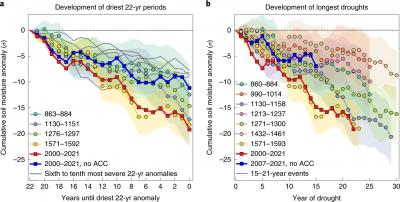Rapid Intensification of the Emerging Southwestern North American Megadrought in 2020–2021
The study used tree rings in the western United States to reconstruct soil moisture conditions back to 800 CE. These reconstructions allowed researchers to estimate that the 2000-2021 period was the driest 22-year period since at least 800 CE. Researchers also used climate models to estimate that 42% of the cumulative soil moisture deficit can be attributed to human-induced warming.
The results have been reported in every major news medium, and have been widely covered in the international press as well. As the drought continues, these results continue to be referenced as an important context for the historical severity of the ongoing drought in the southwestern U.S. and the impact that human-caused climate change has had on the conditions.
Since the year 2000, southwestern North America has been unusually dry due to low precipitation totals and heat, punctuated most recently by an exceptional drought in 2021. From 2000 to 2021, October–September SWNA precipitation was 8.3% below the 1950–1999 average and temperature was 0.91 °C above average. The objective of this research was to quantify how abnormal those conditions have been in the context of the last millennium and whether human impacts on the climate contributed to the severe drought conditions.

